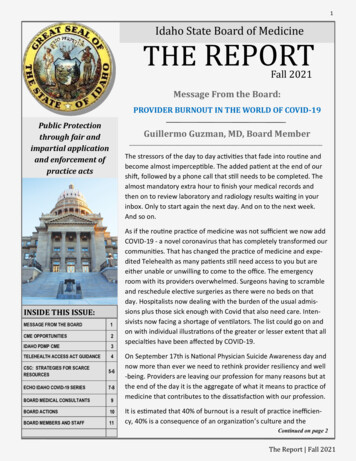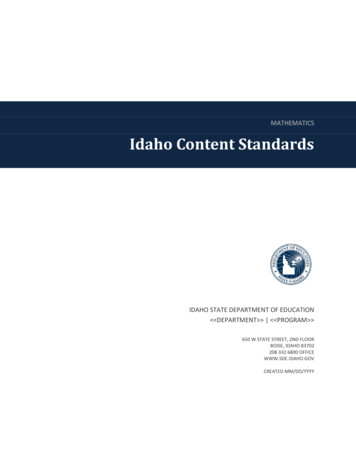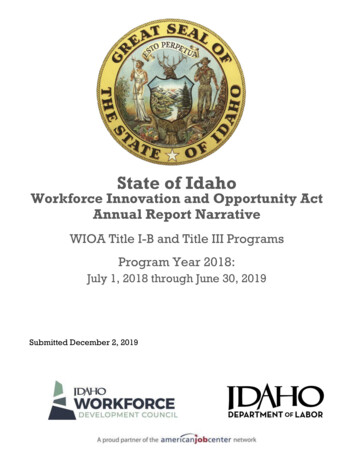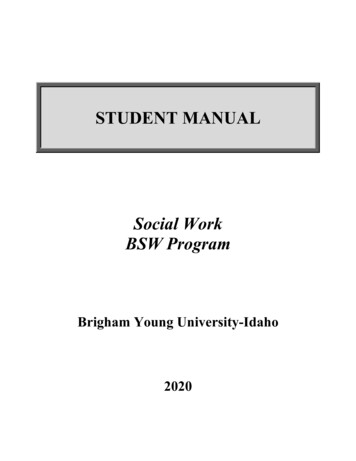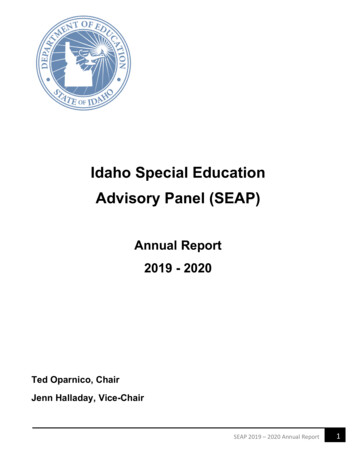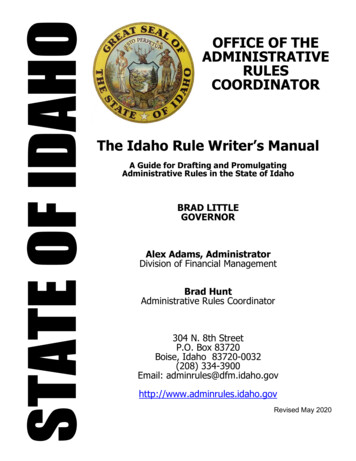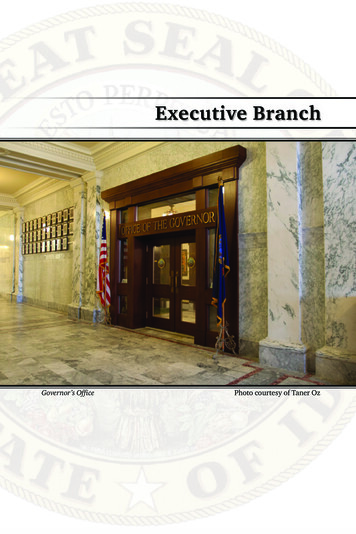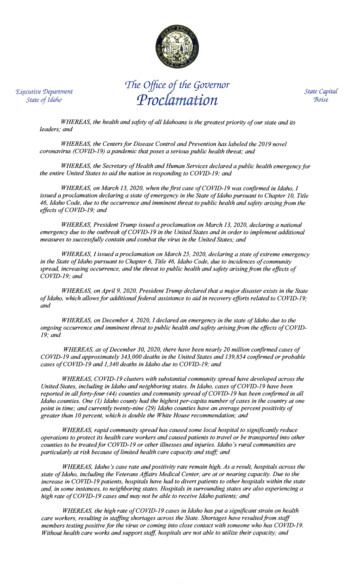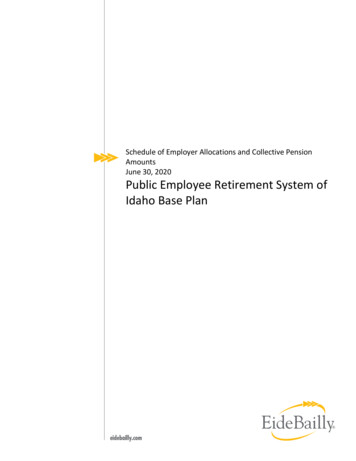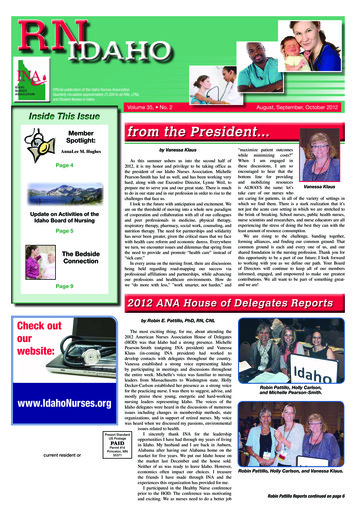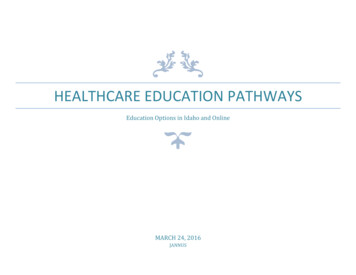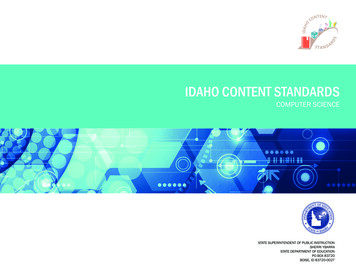
Transcription
IDAHO CONTENT STANDARDSCOMPUTER SCIENCESTATE SUPERINTENDENT OF PUBLIC INSTRUCTIONSHERRI YBARRASTATE DEPARTMENT OF EDUCATIONPO BOX 83720BOISE, ID 83720-0027
Idaho K-12 Content Standards for Computer ScienceThe Computer Science standards build upon frameworks developed by professional organizations, educators, and industry. In particular, they build upon the2016 interim standards put out by CSTA (Computer Science Teachers Association). It is not an exhaustive list of everything in computer science that can belearned within a K-12 pathway, but instead outlines what it means to be literate in Computer Science. Curriculum developers are encouraged to create alearning experience that extends beyond the framework to encompass students’ many interests, abilities, and aspirations.The standards also align with the draft version of the K-12 Computer Science Framework (2016). The framework reflects the latest research in CS education,including learning progressions, trajectories, and computational thinking. The K-12 Computer Science Framework was steered by five organizations: Associationfor Computing Machinery, Code.org, Computer Science Teachers’ Association, Cyber Innovation Center, and National Math and Science Initiative; several states(MD, CA, IN, IA, AR, UT, ID, NE, GA, WA, NC), large school districts (NYC, Chicago, San Francisco); technology companies (Microsoft, Google, Apple); andindividuals (university faculty, researchers, K-12 teachers, and administrators).What is Computer Science?Computer Science is an established discipline at the collegiate and post-graduate levels. It is best defined as “the scientific and engineering approach tocomputation, as well as its applications and impact. It is the systematic study of the feasibility, structure, expression, and mechanization of the methodicalprocedures (or algorithms) that underlie the acquisition, representation, processing, storage, communication of, and access to information.” We will use thefollowing concepts and practices from the K-12 CS Education Framework to structure the standards.The five Core Computer Science Concepts:1. Computing Systems2. Networks and the Internet3. Data and Analysis4. Algorithms and Programming5. Impacts of ComputingThe seven Core Computer Science Practices:1. Fostering an Inclusive Computing Culture2. Collaborating Around Computing3. Recognizing and Defining Computational Problems4. Developing and Using Abstractions5. Creating Computational Artifacts6. Testing and Refining Computational Artifacts7. Communicating About Computing
Idaho K-12 Content Standards for Computer ScienceInternational Society for Technology Education (ISTE Standards):1. Creativity and Innovation2. Communication and Collaboration3. Research and Information Fluency4. Critical Thinking, Problem Solving, and Decision Making5. Digital Citizenship6. Technology Operations and ConceptsNavigating the Idaho Content Standards for Computer ScienceThe Idaho Content Standards for Computer Science is a set of learning standards that provide a foundation for a comprehensive K-12 Computer Sciencecurriculum. The standards are organized by grade bands (K-2, 3-5, K-5, 6-8, 9-10, 11-12 and 9-12) and the five Core Computer Science Concepts as referred to bythe K-12 CS Education Framework ( https://k12cs.org ). It is intentional that some of the grade bands overlap. An item code is designated to facilitate the ease oflocating and identifying specific standards based on the grade band (e.g. K-2), the abbreviated core concept (e.g. CS-Computing Systems), and the orderednumber in the sequence (e.g. K-2.CS.1). The seven Core Computer Science Practices are included to frame the different standards. Also included is a column forthe designation of ISTE (International Society for Technology Education) Standards as they align with the content standards for Computer Science.The standards are not curriculum. Curriculum is determined by the local school districts. The standards clarify the learning outcomes of students. The standardsinform teachers of what students should know, understand, and be able to do. Teachers can create “I can” statements with student friendly language from thestandards. The examples listed within the standards are intended to be suggestions and provide clarification for teachers; they are not intended to be a menu,prescriptive, or all inclusive. While these standards set a foundation of learning statewide, local school districts in Idaho have the discretion to expandexpectations of student learning beyond the state standards. Educators can use the standards in a variety of creative ways.Once standards are introduced and mastered, they become prerequisites and are intended to be included in the curriculum at advanced grade levels. Forexample, the standard 6-8.CS.04 (troubleshooting software and hardware) introduced in Grades 6-8 isn’t explicitly repeated at higher grades as the students willcontinue to practice the skills identified in this standard at higher grade levels. At the high school level, the learning objectives appropriate for all students at thislevel are included in Grades 9-10. Some students will opt for additional, more rigorous elective Computer Science courses in high school. The objectivesappropriate for the subset of high school students focusing more deeply in Computer Science are listed in level Grades 11-12.The standards written for grade bands K-2, 3-5, K-5, and 6-8, have been written with the intent that they can be incorporated into existing classes and subjectareas relevant to each grade band and do not necessitate the creation of a specific Computer Science course to address the standards. However, this does notpreclude local school districts from choosing to create specific Computer Science courses or units at these levels. At the high school level, we expect most localschool districts will create standalone Computer Science courses. Two nationally recognized high school courses that are worth mentioning as models areExploring Computer Science ( http://www.exploringcs.org ) and AP Computer Science Principles ( http://apcsprinciples.org ). These courses don’t cover all of theproposed high school standards but they can serve as model courses for local school districts to adapt to their unique environments.
Idaho K-12 Content Standards for Computer ScienceK-12 CS Standards - Computing Systems (CS)The student will be able to:Core PracticesLocate and identify computing, input, and output devices in a variety of environments (e.g.K-2.CS.01 desktop and laptop computers, tablets, mobile devices, monitors, keyboards, mouse, printers). Communicating About Computing(Grades K-2)ISTE StandardTechnology operations andconceptsK-2.CS.02Demonstrate how to operate a variety of computing devices (e.g. turn on, navigate,open/close programs or apps). (Grades K-2)Communicating About ComputingTechnology operations andconceptsK-2.CS.03Recognize that software is required to control all computing devices (e.g. programs, browsers, Communicating About Computingwebsites, apps). (Grades K-2)Technology operations andconceptsIdentify, using accurate terminology, simple hardware and software problems and applyCritical thinking, problem solvingTesting and Refining ComputationalK-2.CS.04 strategies for solving these problems (e.g. rebooting the device, checking the power, access toand decision making TechnologyArtifactsthe network, read error messages, discuss problems with peers and adults). (Grades K-5)operations and concepts3-5.CS.01Create code to model intelligent behavior in computing devices (e.g. CS unplugged activities,robot programming). (Grades 3-5)Creating Computational ArtifactsCreativity and innovationIdentify, using accurate terminology, simple hardware and software problems and applyCritical thinking, problem solvingTesting and Refining Computational3-5.CS.02 strategies for solving these problems (e.g. rebooting the device, checking the power, access toand decision making TechnologyArtifactsthe network, read error messages, discuss problems with peers and adults). (Grades K-5)operations and conceptsExemplify how computational devices impact the quality of life (both positively and negatively)Fostering an Inclusive Computing6-8.CS.01 and enhance the ability of people to perform work, communicate, and interact with others.Culture(Grades 6-8)6-8.CS.02Compare and contrast the ways that humans and machines process instructions and sense the Developing and Using Abstractionsworld. (Grades 6-8)Communication and collaboration Digital citizenshipCritical thinking, problem solvingand decision makingDifferentiate features of everyday objects that contain computing components (i.e.,6-8.CS.03 computing systems that collect, store, analyze, and/or transmit data) (e.g. Kinect, GoPro,smartphone, car). (Grades 6-8)Developing and Using AbstractionsApply troubleshooting strategies for solving hardware and software problems (e.g.6-8.CS.04recognizing, describing, reproducing, isolating, fixing and retesting). (Grades 6-8)Creativity and innovation CriticalTesting and Refining Computational thinking, problem solving, andArtifactsdecision making Technologyoperations and concepts6-8.CS.05 Compare and contrast the capabilities of different hardware and software in computerCommunicating About ComputingResearch and information fluencyTechnology operations and
Idaho K-12 Content Standards for Computer Sciencesystems (e.g. processors, display types, input devices, communication, and storagecapabilities). (Grades 6-8)conceptsIdentify and evaluate what computing resources are required for a given purpose (e.g. systemFostering an Inclusive Computing9-10.CS.01 requirements needed to run a program, hardware, and software needed to run game X).Culture(Grades 9-10)Creativity and innovation Research and information fluency Critical thinking, problemsolving, and decision making Technology operations andconceptsExplore the unique features of embedded computers in areas such as mobile devices, sensors, Fostering an Inclusive Computingand vehicles. (Grades 9-10)CultureCreativity and innovation Research and information fluency Critical thinking, problemsolving, and decision making Technology operations andconceptsCreate or modify a program that uses different forms of input and output. (e.g. use voice inputCreating Computational Artifactsinstead of text input, use text-to-speech for output) (Grades 9-10)Creativity and innovation Research and information fluency Critical thinking, problemsolving, and decision making Technology operations andconcepts9-10.CS.029-10.CS.03Developing and Using AbstractionsCreativity and innovation Communication and collaboration Critical thinking, problemsolving, and decision making Technology operations andconceptsCommunicating About ComputingCritical thinking, problem solvingand decision making Technologyoperations and conceptsCreate a model of how embedded systems sense, process, and actuate in a given environment11-12.CS.02Communicating About Computing(e.g. ocean, atmosphere, and highway) (Grades 11-12)Critical thinking, problem solvingand decision making Technologyoperations and conceptsDemonstrate the multiple levels of abstraction that support program execution including9-10.CS.04 programming languages, translations, and low-level systems including the fetch-execute cycle(e.g. model, dance, create a play/presentation). (Grades 9-10)11-12.CS.01Identify and describe hardware (e.g. physical layers, logic gates, chips, components). (Grades11-12)
Idaho K-12 Content Standards for Computer ScienceK-12 CS Standards - Data and Analysis (DA)The student will be able to:Core PracticesISTE StandardK-2.DA.01Classify and sort information into useful order without using a computer (e.g. sorting objectsby various attributes). (Grades K-2)Fostering an Inclusive ComputingCultureK-2.DA.02Demonstrate that computing devices save information as data that can be stored, searched,retrieved, modified, and deleted. (Grades K-2)Developing and Using AbstractionsResearch and information fluency Technology operations andconceptsDeveloping and Using AbstractionsCommunication and collaboration Technology operations andconceptsExplain that networks, like the Internet, link people using computers and other computingK-2.DA.03 devices allowing them to communicate, access, and share information. (Grades K-2)3-5.DA.01Use outcome data (results) from running a simulation to solve a problem or answer a question Recognizing and Definingin a core subject area, either individually or collaboratively. (Grades 3-5)Computational ProblemsUnderstand how computers encode and store data (e.g. simple mapping of binary number to3-5.DA.02decimal number, letter, or color). (Grades 3-5)Developing and Using AbstractionsResearch and information fluencyCommunication and collaboration Critical thinking, problemsolving and decision makingCommunication and collaboration Technology operations andconcepts3-5.DA.03Gather, manipulate, and evaluate data to explore a real world problem that is of interest to the Recognizing and Definingstudent. (Grades 3-5)Computational ProblemsResearch and information fluency Critical thinking, problemsolving, and decision making6-8.DA.01Describe the trade-off between quality and file size of stored data (e.g. music, video, text,images). (Grades 6-8)Technology operations andconceptsCommunicating About Computing6-8.DA.02Defend the selection of the data, collection, and analysis needed to answer a question. (GradesCommunicating About Computing6-8)Communication and collaboration Research and informationfluency Critical thinking,problem solving, and decisionmaking6-8.DA.03Understand that data collection is used to make recommendations to influence decisions aswell as predict behavior. List the positive and negative impacts. (Grades 6-8)Research and information fluency Critical thinking, problemsolving, and decision makingFostering an Inclusive ComputingCulture
Idaho K-12 Content Standards for Computer Science6-8.DA.04Encode and decode information using encryption/decryption schemes. (e.g. Morse code,Unicode, binary, symbols, student-created codes, simple ciphers). (Grades 6-8)6-8.DA.05Identify layers of abstraction in different contexts (e.g. video and animation are made of audioDeveloping and Using Abstractionsand video frames, which are made of pixels, which are made of color codes). (Grades 6-8)Critical thinking, problem solving,and decision making Technologyoperations and conceptsIllustrate how various types of data are stored in a computer system (e.g. how sound andimages are stored). (Grades 9-10)Communicating About ComputingCommunication and collaboration Critical thinking, problemsolving, and decision making Technology operations andconceptsCommunicating About ComputingCommunication and collaboration Critical thinking, problemsolving, and decision making Digital citizenship Technologyoperations and conceptsCompare and contrast the viewpoints on cybersecurity from the perspective of security9-10.DA.03 experts, privacy advocates, the government (e.g. persuasive essay, presentation, or debate).(Grades 9-12)Fostering an Inclusive ComputingCultureCommunication and collaboration Critical thinking, problemsolving, and decision making Digital citizenshipExplain the principles of security by examining encryption, cryptography, and authentication9-10.DA.04techniques. (Grades 9-12)Recognizing and DefiningComputational ProblemsCritical thinking, problem solving,and decision making DigitalcitizenshipRecognizing and DefiningComputational ProblemsResearch and information fluency Technology operations andconceptsDeveloping and Using AbstractionsResearch and information fluency Technology operations andconceptsDeveloping and Using AbstractionsResearch and information fluency Critical thinking, problemsolving, and decision making Technology operations and9-10.DA.019-10.DA.029-10.DA.05Differentiate between information access and distribution rights (e.g. write, discuss). (Grades9-10)Apply basic techniques for locating, collecting, and understanding the quality of small andlarge-scale data sets (e.g. public data sets). (Grades 9-10)Convert between binary, decimal, octal, and hexadecimal representations of data. (Grades9-10.DA.069-10)Analyze the representation and trade-offs among various forms of digital information (e.g.9-10.DA.07lossy versus lossless compression). (Grades 9-10)Developing and Using AbstractionsTechnology operations andconcepts
Idaho K-12 Content Standards for Computer ScienceconceptsDeveloping and Using AbstractionsResearch and information fluency Critical thinking, problemsolving, and decision making Technology operations andconceptsFostering an Inclusive ComputingCultureResearch and information fluency Critical thinking, problemsolving, and decision making Technology operations andconceptsUse various data collection techniques for different types of problems (e.g. mobile device GPS,Fostering an Inclusive Computing11-12.DA.02 user surveys, embedded system sensors , open data sets, social media data sets ). (GradesCulture11-12)Research and information fluency Critical thinking, problemsolving, and decision making Technology operations andconcepts9-10.DA.08 Analyze data and identify patterns through modeling and simulation.(Grades 9-12)Use data analysis to enhance understanding and gain knowledge of complex systems to show11-12.DA.01 the transformation from data to information to knowledge (e.g. using existing data sets).(Grades 11-12)11-12.DA.03Understand and explain security policies by comparing encryption and authenticationstrategies (e.g. trapdoor functions and man in the middle attacks). (Grades 11-12)Recognizing and DefiningComputational Problems11-12.DA.04Discuss the variety of interpretations of binary sequences (e.g. instructions, numbers, text,sound, image). (Grades 11-12)Developing and Using Abstractions11-12.DA.05Use models and simulations to help formulate, refine, and test scientific hypotheses. (Grades11-12)11-12.DA.06 Analyze data and identify patterns through modeling and simulation.(Grades 9-12)Creativity and innovation Research and information fluency Critical thinking, problemsolving, and decision making Technology operations andconceptsTechnology operations andconceptsDeveloping and Using AbstractionsResearch and information fluency Critical thinking, problemsolving, and decision making Technology operations andconceptsDeveloping and Using AbstractionsResearch and information fluency Critical thinking, problem solving,and decision making Technology
Idaho K-12 Content Standards for Computer Scienceoperations and conceptsK-12 CS Standards - Impacts of Computing (IC)The student will be able to:Core PracticesISTE StandardK-2.IC.01Practice responsible digital citizenship (legal and ethical behaviors) in the use of technologysystems and software. (Grades K-5)Fostering an Inclusive ComputingCultureDigital citizenshipK-2.IC.02Understand that a wide range of jobs require knowledge or use of computer science. (GradesK-2)Fostering an Inclusive ComputingCultureResearch and informationfluency3-5.IC.01Practice responsible digital citizenship (legal and ethical behaviors) in the use of technologysystems and software. (Grades K-5)Fostering an Inclusive ComputingCultureDigital citizenshipFostering an Inclusive ComputingCultureResearch and informationfluency Critical thinking,problem solving, and decisionmaking3-5.IC.02 Explore the connections between computer science and other fields. (Grades 3-5)3-5.IC.03Generate examples of how the use of computing can affect society and how society caninfluence the use of computing. (Grades 3-5)Fostering an Inclusive ComputingCultureCommunication andcollaboration3-5.IC.04Explain ethical issues that relate to computers and networks (e.g. equity of access, security,privacy, copyright, digital citizenship, and intellectual property). (Grades 3-5)Fostering an Inclusive ComputingCultureDigital citizenshipEvaluate the positive and negative impacts of computing devices in daily life. (e.g.,downloading videos and audio files, electronic appliances, wireless Internet, mobile computing Fostering an Inclusive Computing3-5.IC.05devices, GPS systems, Internet of Things, wearable computing). Describe the pros and cons of Culturethese impacts.(Grades 3-5)Digital citizenshipExplore security risks associated with using weak passwords, lack of encryption and/or insecure6-8.IC.01Communicating About Computingtransactions. (Grades 6-8)Critical thinking, problem solving,and decision making Digitalcitizenship Technologyoperations and concepts6-8.IC.02Explore how computer science fosters innovation and enhances other careers and disciplines.(Grades 6-8)Communicating About ComputingCreativity and innovation Research and informationfluency Technology operationsand concepts
Idaho K-12 Content Standards for Computer ScienceFostering an Inclusive ComputingCultureCreativity and innovation Research and informationfluency Digital Citizenship Technology operations andconceptsFostering an Inclusive ComputingCultureCreativity and innovation Communication andcollaborationDesign, develop, and present computational artifacts that have a positive social impact (e.g.web pages, mobile applications, animations). (Grades 6-8)Creating Computational ArtifactsCreativity and innovation Communication andcollaboration Critical thinking,problem solving, and decisionmaking6-8.IC.06Redesign user interfaces to be more inclusive, accessible, and minimizing the impact of thedesigner's inherent bias. (e.g. web pages, mobile applications, animations). (Grades 6-8)Creativity and innovation Communication andTesting and Refining Computational collaboration Research andArtifactsinformation fluency Criticalthinking, problem solving, anddecision making6-8.IC.07Understand and explain the elements of federal, state, and local regulations that relate todigital citizenship (e.g. COPPA, CIPA, state laws, district policies). (Grades 6-8)Fostering an Inclusive ComputingCultureDigital citizenshipFostering an Inclusive ComputingCultureCreativity and innovation Research and informationfluency Technology operationsand conceptsPredict positive and negative social impacts of existing or student created content and6-8.IC.09computational artifacts (e.g. economic, entertainment, education, or political). (Grades 6-8)Collaborating around ComputingCritical thinking, problem solving,and decision making Digitalcitizenship Technologyoperations and conceptsExplain the social and economic implications associated with unethical computing practices(e.g. software piracy, intrusion, malware, current corporate fraud examples). (Grades 9-10)Collaborating around ComputingCritical thinking, problem solving,and decision making Digitalcitizenship Technology6-8.IC.03Describe ethical issues that relate to computers and networks (e.g. equity of access, security,privacy, ownership and information sharing, copyright, licensing). (Grades 6-8)6-8.IC.04 Explore how the Internet impacts global communication and collaboration. (Grades 6-8)6-8.IC.056-8.IC.089-10.IC.01Summarize current events and changes resulting from computing and their effects oneducation, the workplace, and society. (Grades 6-8)
Idaho K-12 Content Standards for Computer Scienceoperations and conceptsCommunicating About ComputingCommunication andcollaboration Research andinformation fluency Digitalcitizenship Technologyoperations and conceptsCommunicating About ComputingCritical thinking, problem solving,and decision making Technology operations andconceptsDescribe how computer science shares features with creating and designing an artifact such asCommunicating About Computingin music and art. (Grades 9-12)Critical thinking, problem solving,and decision making Technology operations andconceptsDemonstrate how computing enhances traditional forms and enables new forms ofexperience, expression, communication, and collaboration (e.g. virtual reality). (Grades 9-10)Fostering an Inclusive ComputingCultureCreativity and innovation Communication andcollaboration Critical thinking,problem solving, and decisionmaking Technology operationsand conceptsFostering an Inclusive ComputingCultureCommunication andcollaboration Research andinformation fluency Criticalthinking, problem solving, anddecision making DigitalcitizenshipDiscuss trade-offs such as privacy, safety, and convenience associated with the collection and9-10.IC.02 large scale analysis of information about individuals (e.g. social media, online shopping, howgrocery/dept stores collect and use personal data). (Grades 9-10)9-10.IC.03 Understand and explain the impact of artificial intelligence and robotics. (Grades 9-10)9-10.IC.049-10.IC.059-10.IC.06Explain the impact of the digital divide on access to critical information (e.g. education,healthcare, medical records, access to training). (Grades 9-10)
Idaho K-12 Content Standards for Computer ScienceCompare the positive and negative impacts of computing on behavior and culture. 109-10.IC.11Fostering an Inclusive ComputingCultureCommunication andcollaboration Research andinformation fluency Criticalthinking, problem solving, anddecision making DigitalcitizenshipEvaluate a computational artifact for its effectiveness for universal access (e.g. comparesample code with accessibility standards, building in access from initial design). (Grades 9-10)Research and informationfluency Critical thinking,Testing and Refining Computationalproblem solving, and decisionArtifactsmaking Technology operationsand conceptsPractice responsible digital citizenship (legal and ethical behaviors) in the use of technologysystems and software. (Grades 9-10)Fostering an Inclusive ComputingCultureDigital citizenshipCommunicating About ComputingCommunication andcollaboration Research andinformation fluency Criticalthinking, problem solving, anddecision making DigitalcitizenshipExplain how computer science fosters innovation and enhances other careers and disciplines.(Grades 6-8)Explain the impacts of computing on business, manufacturing, commerce, and society. (Grades Fostering an Inclusive Computing9-12)CultureUnderstand the ecosystem of open source software development and its impact on global11-12.IC.01 collaboration through an open-source software project (e.g. https://codein.withgoogle.com).(Grades 11-12)Collaborating around ComputingCommunication andcollaboration Research andinformation fluency Criticalthinking, problem solving, anddecision making DigitalcitizenshipResearch and informationfluency; Critical thinking,problem solving, and decisionmaking; Digital citizenship;Technology operations andconcepts
Idaho K-12 Content Standards for Computer ScienceDebate laws and regulations that impact the development and use of software. (e.g. compare11-12.IC.02 and contrast licensing versus certification, professional societies, professional code of ethics).(Grades 11-12)11-12.IC.03Research, analyze, and present how computational thinking has revolutionized an aspect of our Fostering an Inclusive Computingculture (e.g. agriculture, communication, work, healthcare, music, art). (Grades 11-12)CultureCreativity and innovation Research and informationfluency Critical thinking,problem solving, and decisionmaking Digital citizenship Technology operations andconceptsFostering an Inclusive ComputingCultureResearch and informationfluency Critical thinking,problem solving, and decisionmaking Digital citizenshipFostering an Inclusive ComputingCultureCommunication andcollaboration Research andinformation fluency Criticalthinking, problem solving, anddecision makingDeveloping and Using AbstractionsResearch and informationfluency Critical thinking,problem solving, and decisionmaking Digital citizenshipFostering an Inclusive ComputingCultureDigital citizenship11-12.IC.04 Analyze the role and impact of government regulation on privacy and security. (Grades 11-12)11-12.IC.05Debate how the issues of equity, access, and power relate to the distribution of computingresources in a global society. (Grades 11-12)Identify and evaluate the beneficial and harmful effects of computing innovations. (Grades11-12.IC.0611-12)11-12.IC.07Communicating About ComputingCommunication andcollaboration Research andinformation fluency Criticalthinking, problem solving, anddecision making Digitalcitizenship Technologyoperations and conceptsPractice responsible digital citizenship (legal and ethical behaviors) in the use of technologysystems and software. (Grades 11-12)Describe how computer science shares features with creating and designing an artifact such as11-12.IC.08Communicating About Computingin music and art. (Grades 9-12)Critical thinking, problem solving,and decision making Technology operations and
Idaho K-12 Content Standards for Computer Scienceconcepts11-12.IC.0911-12.IC.10Explain the impacts of computing on business, manufacturing, commerce, and society. (Grades Fostering an Inclusive Computing9-12)CultureCommunication andcollaboration Research andinformation fluency Criticalthinking, problem solving, anddecision making DigitalcitizenshipSummarize how computer automation and control is transforming society and the globaleconomy (e.g. financial markets, transactions, predictions). (Grades 11-12)Communication andcollaboration Research andinformation fluency Criticalthinking, problem solving, anddecision making DigitalcitizenshipK-12 CS Standards - Networks and the Internet (NI)The student will be able to:3-5.NI.01 Demonstrate how a device on a network sends and receives information. (Grades 3-5)Simulate the flow of information as packets on the Internet and networks (e.g. model using6-8.NI.01strings and paper, note passing). (Grades 6-8)6-8.NI.02Compare and contrast the tr
The Idaho Content Standards for Computer Science is a set of learning standards that provide a foundation for a comprehensive K-12 Computer Science curriculum. The standards are organized by grade bands (K-2, 3-5, K-5, 6-8, 9-10, 11-12 and 9-12) and the five Core Computer Science Concepts as referred to by
